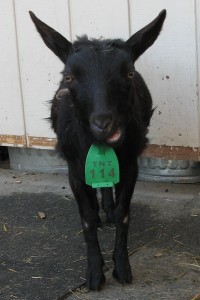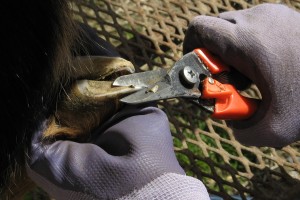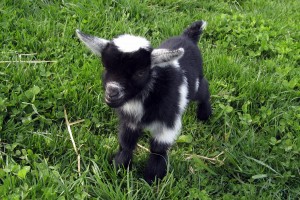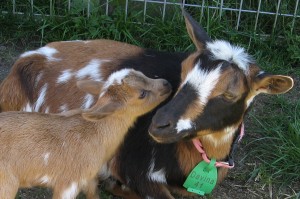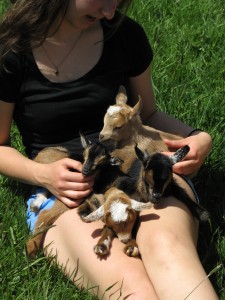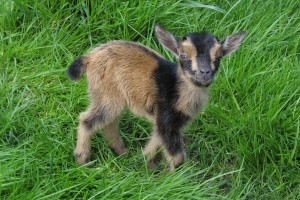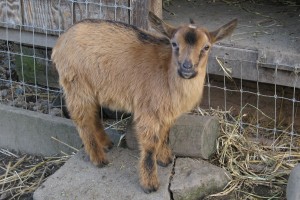My ninth farm was Left Foot Farm in Eatonville, Washington.
The Farm
The farmer is Jeremy. In December 2010, he fulfilled a dream and bought twenty-five acres in an area only five minutes from where he grew up in Eatonville, Washington. At that time he was living with a girlfriend who wanted a few goats. The girlfriend eventually left the farm, but the goats stayed. Jeremy wanted a way to make money from the goats so he decided to sell raw milk. To get enough milk, he had to increase his herd of Nigerian Dwarf goats. He now has around eighty goats and milks around thirty-six. He breeds for quality. One of his does was second in the country for milk production. Her kids fetch a high price. Jeremy is always looking for new ventures on his farm. He was raising pigs while I was there, and just got bee hives. One of his main goals is to offer education to the public on farming and goat care.
My Farm Experience
“There are seven goats due in April and one of them is due in the next few days,” Jeremy responded to my email enquiry about the possibility of any births while I was on the farm in April. I was looking forward to seeing the birthing process and bottle feeding baby goats. I also knew that death was a reality of farming and I had an odd feeling that would be part of my experience as well.
The farm had a solid crew of around seven WWOOFers at any given time. WWOOFers would leave and new ones would come to take their place. Most stayed a few months. They all had previous WWOOFing experience and were great to work with. I felt we were a team of ‘professional’ WWOOFers. There was also a farm manager named Kerri who did the initial training and kept everything well organized. All of us had our own little cabin. The cabins were clustered in one of the goat pastures next to the main house. Jeremy lived on the main floor of the house. The garage had been converted into the WWOOFer lounge and kitchen. The kitchen was stocked with everything imaginable. We cooked our own meals and ate very well.
Our days revolved around daily chores. A schedule was posted on our fridge and we were assigned different chores each day. The chores were:
AM Milking
AM Feeding
Mid-Morning Feeding
Chores
PM Milking
PM feeding
All of the chores were great because they all worked with the goats in some way. Milking gave the most time with goats. The feedings were fun because they included bottle feeding the babies. One of the tasks during Chores was hoof trimming, clipping the overgrown edges off hooves.
I was excited to see newborn baby goats, and I didn’t have to wait long. Two days after I arrived, when I walked into the WWOOFer lounge to have breakfast, I learned that two baby goats had been born during the night. Of course, I skipped breakfast and ran up to see them. The nursery was filled with the sounds of the mother goat talking to her two baby boys. One was white and black and named Skyy, and the other was black with white ears and forehead patch. His name was Slate. Skyy was a mama’s boy and Slate the adventurous one. On seeing this I immediately changed my allegiance from Skyy to Slate. Their mother Sapphire, whom I was to grow fond of, was a good mother, attentively calling to her babies and keeping their butts clean. The day wasn’t finished with new births yet. Twelve tiny chicks were discovered in a nest away from the hen house. When I opened the door to their shed, I head loud ‘peep’ ‘peep’ ‘peep’ and saw chicks in a rainbow of colors: yellow, brown, black, white and red. I stood watching them run around on the floor of the shed. Then suddenly there were only four left. Where did they all go? I watched the final four disappear one by one under their mother. She stood there wings puffed out with many pairs of tiny yellow legs just visible under her chest. It struck me that farm life was accurately portrayed in Looney Tunes cartoons.
One of my favorite activities on the farm was bottle feeding the baby goats. The babies were taken away from their mother after three days so the farm could get the mother’s valuable milk. The babies were moved to a grassy area with a little garden shed-sized structure for them to eat and sleep in. At feeding time, they ran into the shed and let out loud ‘maa’s in anticipation. When I opened the shed door, they poured out, springing over an eight inch wood barrier. Very cute! When I first arrived on the farm, there were seven two-month-old babies to bottle feed: Doey, little Bokkie, Rolo, Ace and the Vs, Vilma, Valentine and V. They were heavy enough that they were difficult to hold under one arm, especially when I didn’t yet know the technique of holding them. Their stomachs inflated as they drank their milk, and then they slid away down my side and onto the ground. They had to jump back on the top of the picnic table, and I had to grab them around the middle again so they could finish their bottle of milk. I didn’t get to feed the big ones for very long. It was time for them to be weaned. Doey, little Bokkie and Rolo got to move up to the bigger goat pen. Goats are like people and ostracize newcomers. It rained the day after they were moved to their new pen. The other goats wouldn’t let them inside the shed. They stood outside in the rain crying. I’m sure a lot of people have had similar experiences. Eventually one of the outgoing goats befriended them and they had a new play buddy.
Everyone was excited because the farm was going to sell raw milk at two farmers markets during the summer. A few weeks into the season, things got interesting. An inspector noticed that customers were being given samples of the raw milk. The inspector came over and said raw milk couldn’t be sold at the farmers market. It turned out the farmers markets had been set up in the one county in the area that didn’t allow raw milk to be sold at farmers markets. The county health department is concerned that the milk might not be kept refrigerated below 41 degrees and that people don’t understand what they would be drinking. There was a strong feeling of consternation on the farm after hearing the news. Immediately, Tootsie, goat spokesperson and renegade, put out a public statement.
My first farm death happened my second week. A litter of twelve puppies was born. Their parents were gigantic livestock guardian dogs. The puppies looked like hamsters. They squealed and were blind. Everything seemed to be going fine with all of them for a few days, then someone noticed that one of them was weak and hadn’t been eating. It was brought inside to be tube fed at intervals during the night. The puppy didn’t make it to its second feeding. It was put in a shoebox to be buried in the goat graveyard across the street. At least it wasn’t a goat, I thought.
One Thursday morning when I went into the lounge for coffee before starting my chores, I heard that Bethany, a goat, had given birth. Two of the kids were dead but one was alive and doing fine. Bethany was a first time mom and it appeared she didn’t know what to do with her babies. One baby showed no obvious reason why it should have died and the other one was still in the amniotic sac. It was thought that Bethany hadn’t licked them to clear their passages to get them breathing. Possibly they could have been saved if someone had been there for the births. She gave birth in between the two hour intervals when she was being checked on. The surviving buckling was named Fig. Bethany wasn’t going to win mom of the year. Kerri had to clean the poo off Fig’s bum because Bethany wasn’t doing it.
We were all waiting for the tremendously pregnant Davina to give birth. She is a beautiful orange goat with black and white markings. She looked ready to burst. More than once we found her lying down with a hind leg outstretched, pushing and moaning. Her cervix was dilated so we thought the babies were on their way. Then she would get up, walk over to the feeder and start eating. No babies that day. As time went on, we joked that if she’s feigning labor, maybe she’s also feigning pregnancy. But then late one evening, someone saw a clear discharge, a certain sign of the beginning of labor. She was moved to the nursery, and Jeremy set up a lounge chair and his computer for the long wait ahead. I wanted to see the kidding process and I was hoping to see a goat have four babies. Davina seemed like she had at least four inside her. However, it was going to be a while before any kids appeared so I went to bed vowing to get up and check on what was happening should I wake up during the night. I slept soundly so I heard the unfortunate story the next morning. The first three kids were stillborn, but the fourth was alive. He was plain beige but had striking eyes. He was named Ron. In all, that was five babies that hadn’t survived being born. I hadn’t seen any of them and none of them had had a start on life. My sense of foreboding was still there. To me, the only death that would ‘count’ was that of a goat that I knew.
The day after the babies were born, we took them outside to a grassy area. The first thing the kids did was test out their legs. They stomped stiff legged, bouncing sideways. When they got tired of that, they ran sideways kicking up their back legs. If someone got a good video of it, it would be a YouTube sensation for sure. Finally, they curled up like cats and enjoyed the sunshine and fresh air.
The shed of little baby goats was growing. There was Slate the oldest (Skyy had gone off with his new owner), Mooninite who looked like Slate, Fig who had a less than attentive mother, Ron with the dashing eyes and three pretty triplets who got overshadowed by all the other births. They were all small and a perfect size to hold while bottle feeding. They were given a warmed mixture of cow’s milk, yogurt made from the farm’s does, whipped cream and a nutritional supplement. Yum! The only downside to the bottle feeding was hearing the first time moms crying relentlessly for their babies. Where did they go? They were just here a moment ago and now they’re gone? Sapphire always came running to me hoping I’d help her find them. The does who had kidded before didn’t cry, they did a bit of head butting to get back into the herd, but otherwise their lives returned to normal. The kids didn’t cry at all. They immediately took to their new independence and made friends with the other young goats. They also trusted and liked humans which made them more fun to be around.
“Peony’s having babies!” Madeline called out to me in the dark after checking on the pregnant goats before going to bed. I hurried over to the pen and found a baby already there. Peony and her baby were moved to the nursery which was already full with Davina and Ron, and Dreamer and her three doelings. I held Peony’s first baby who I named Sage while Jeremy used his fingers to massage Peony to get her to push. Two dark legs appeared but no head. The second kid was coming out backwards. Jeremy pulled and the little goat easily slid out. The doeling was black on the front half of her body and brown on the other half. Madeline held her and named her Rosemary. Jeremy showed us how to put our hands under Peony’s stomach and ‘bounce’ her to feel if there were any more babies inside. We could feel a hard bump so there was at least one more. Jeremy continued massaging and Peony pushed another set of legs out. After Jeremy pulled the third goat out, Emily said, “That goat’s so small!” Looking again at it I noticed its legs were thin like matchsticks. The little doe only weighed 1 pound 4 ounces. “Will she be able to stand and nurse?” Emily asked. “If she doesn’t she won’t make it,” Jeremy responded truthfully. The little goat, a twin to Rosemary, who we named Thyme, sat on the ground with her front legs splayed out and her head up. When she was picked up and showed a teat, she suckled strongly. She had a determined look about her and I thought she’d be fine. After the excitement of the tiny goat started to pass, Jeremy realized that such a small goat couldn’t have made such a large bump in Peony. Jeremy massaged Peony again and the biggest of the four goats came out. This doeling was a beautiful beige-orange with three little white socks. Jeremy was ready for bed at this point. The nameless fourth kid was shown a teat and suckled. We said a hasty good night to the newborns and went off to bed. The next morning I went directly to the nursery to check on little Thyme. She was standing and taking a very long drink from her mom. She’d probably grown some too. Madeline had been puzzling over a name for the fourth goat. Later in the morning, she walked by and called out “Parsley!”
Four days before I was leaving the farm I was doing AM feeding. When I went into the shed that had the first goats I bottle fed when I arrived on the farm, I noticed that Rolo didn’t jump in with the others to eat the hay I’d put in the feeder. He stood away from the feeder looking sad. I noted that on the whiteboard under ‘kid concerns’ and Kerri checked his temperature later that day. He had a slight fever. Later in the day, during the PM feeding Thyme and her siblings were getting one of their first bottle feedings. I stopped by to watch. As the new babies wandered around the bottle feeding area, they came across the older goats. They bumped noses through the fence with Doey and little Bokkie. Where was Rolo? When I opened the shed, he was on his side crying. I went to get Kerri. By the time she got there, Rolo was taking his last breaths. We were all stunned; it was completely unexpected. Why did he suddenly die? The vet did an autopsy and said he may have had congenital heart failure. So my premonition of experiencing a death while on this farm did become reality. I’d rather it hadn’t, but it was something that was going to happen soon or later if I was going to work with animals on a farm.

